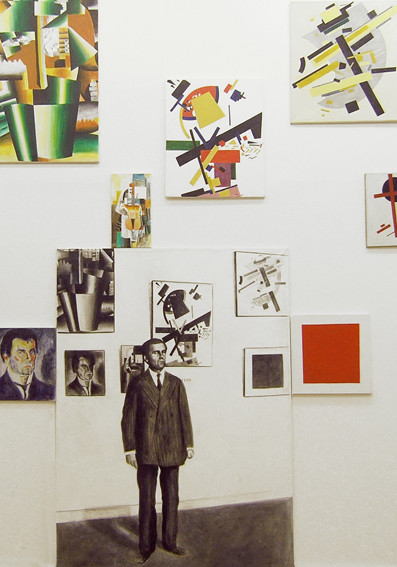Kazimir Malevich
27 Jun - 19 Sep 2009
Kazimir Malevich’s AUTOBIOGRAPHY is a documentary exhibition that traces the work of one of the most important artists of the 20th century until his death and after. We should not see the artefacts at this exhibition as works of art. Rather they are souvenirs, sellected speciments of our collective memory.
– Walter Benjamin
The theme of the exhibition AUTOBIOGRAPHY is the life and work of Kazimir Malevich, dating from Petrograd’s “The Last Futurist Exhibition 0:10” of 1915 to the appearance of his work at present.
AUTOBIOGRAPHY speaks about this avant-garde artist, whose works were considered examples of negative “bourgeois formalist” art in his homeland in the 1930s while, at the same time in North America, they found themselves part of the core canon of Alfred H. Barr, the director of the Museum of Modern Art in New York. Over the course of the 20th century, then, Malevich became an icon of modern art, and today represents our historically fortified canon about how new art is perceived. But long after the end of his creative career in the Soviet Union, Malevich appeared again in 1985 in Belgrade and in 1986 in Ljubljana with an installation of The Last Futurist Show. This was a case of anonymous authorship, but nonetheless these suprematist paintings were works by Kazimir Malevich, though now they were dated 1985.
On view in the present exhibition, then, are suprematist works dated 1985. The paintings show Malevich and his life, and the way his works are perceived, from being a symbol of spiritual creativity to being commodities on today’s art market. The pictures show the history of art through the prism of one of the heroes of modernism and illustrate the method of the linear historical record, while at the same time they undermine the authenticity of the artwork, the authorship of the original, the notion of parallel temporality, and the reliability of the document as a historical tool for establishing hierarchical order and value in the art system.
The exhibition in Berlin focuses on the 1927 “Grosse Berliner Kunstausstellung” where Malevich had a retrospective exhibition of 70 paintings. After this show, all the works were transported to the Landesmuseum in Hannover and remained there in the custody of museum director Alexander Dorner. In 1935 the director of Museum of Modern Art, Alfred Barr, took several paintings from Dorner and brought them to New York. The paintings were shown at the landmark "Cubism and Abstract Art" exhibition at MoMA in 1936. After the show, the works remained on permanent display at MoMA during which time they could not be seen anywhere else in the world. It is likely thanks to “Grosse Berliner Kunstausstellung”, to Alexander Dorner, and to Alfred Barr, that we know about Malevich today.
Special thanks to Moderna galerija, Ljubljana.
For more information, please write to berlin@gregorpodnar.com
– Walter Benjamin
The theme of the exhibition AUTOBIOGRAPHY is the life and work of Kazimir Malevich, dating from Petrograd’s “The Last Futurist Exhibition 0:10” of 1915 to the appearance of his work at present.
AUTOBIOGRAPHY speaks about this avant-garde artist, whose works were considered examples of negative “bourgeois formalist” art in his homeland in the 1930s while, at the same time in North America, they found themselves part of the core canon of Alfred H. Barr, the director of the Museum of Modern Art in New York. Over the course of the 20th century, then, Malevich became an icon of modern art, and today represents our historically fortified canon about how new art is perceived. But long after the end of his creative career in the Soviet Union, Malevich appeared again in 1985 in Belgrade and in 1986 in Ljubljana with an installation of The Last Futurist Show. This was a case of anonymous authorship, but nonetheless these suprematist paintings were works by Kazimir Malevich, though now they were dated 1985.
On view in the present exhibition, then, are suprematist works dated 1985. The paintings show Malevich and his life, and the way his works are perceived, from being a symbol of spiritual creativity to being commodities on today’s art market. The pictures show the history of art through the prism of one of the heroes of modernism and illustrate the method of the linear historical record, while at the same time they undermine the authenticity of the artwork, the authorship of the original, the notion of parallel temporality, and the reliability of the document as a historical tool for establishing hierarchical order and value in the art system.
The exhibition in Berlin focuses on the 1927 “Grosse Berliner Kunstausstellung” where Malevich had a retrospective exhibition of 70 paintings. After this show, all the works were transported to the Landesmuseum in Hannover and remained there in the custody of museum director Alexander Dorner. In 1935 the director of Museum of Modern Art, Alfred Barr, took several paintings from Dorner and brought them to New York. The paintings were shown at the landmark "Cubism and Abstract Art" exhibition at MoMA in 1936. After the show, the works remained on permanent display at MoMA during which time they could not be seen anywhere else in the world. It is likely thanks to “Grosse Berliner Kunstausstellung”, to Alexander Dorner, and to Alfred Barr, that we know about Malevich today.
Special thanks to Moderna galerija, Ljubljana.
For more information, please write to berlin@gregorpodnar.com

